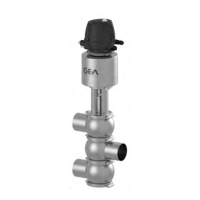9.7.4 Lubricating seals and threads
Prerequisites
●
The valve has been removed, see
9.5 Removing the valve
.
Tools
●
Lubricants Rivolta F.L.G. MD-2 and PARALIQ GTE
ATTENTION
Damage to seals and threads
Stainless steel threads tend to seize and stick, and must be greased. Damage to seals
and threads can r
esult in malfunction.
●
Ensure that an adequate lm of lubricant is applied. No grease residues must be
visible once the valve has been assembled completely.
●
For product contact seals only use suitable greases and oils.
●
Observe the safety data sheets issued by the lubricant manufacturer.
1. Apply a light lm of lubricant to all threads.
2. Gr
ease all seals – including the O-rings at the top and bottom of the actuator pis-
ton stem – very thinly.
®
Do not grease the V-ring.
3. Grease the inside of the seal ring (1) (contact surface).
Þ
Seals and threads have been lubricated.
INFO GEA Tuchenhagen recommends Rivolta F.L.G. MD-2 and PARALIQ GTE
703. These
lubricants are approved for foodstuff and are resistant to
beer froth. They have the NSF-H1 (USDA H1) registration. They do not
affect the taste or the consistency of the products and are compatible
with the seals in contact with product. Rivolta F.L.G. MD-2 can be or-
dered from GEA Tuchenhagen. Using other types of grease can result
in malfunctions or in premature seal failure. The warranty will also be-
come null and void. A Manufacturer's Declaration for these products
can be obtained from GEA Tuchenhagen if required. A thin lm of
grease is required on the seals to ensure the proper function of the t-
tings. It reduces friction and extends the service life of the seals. This is
absolutely harmless from a health and hygienic point of view. Running
dry must be avoided!
9.7 Maintenance - 87 / 104

